1. Laksa
Laksa is in my books, the quintessential dish of Singapore. Though it exists in Malaysia with various regional styles, the true origin of Laksa is unknown and often heavily debated.
In Singapore, laksa is a shrimp-heavy dish as the rich umami-laden broth is made with prawn stock and minced dried shrimp.
Typically, toppings will include fish cakes, a hard boiled egg, tofu puffs and cockles. I would ask to omit cockles if you’ve never had it before, because even for my local palate, I find them very fishy and an acquired taste, though many would disagree.

My favourite laksa is one I’ve been eating since for the past 20 years near my estate in the north, Yishun. Although relatively unknown to people living away from the north, ‘Yishun Block 928 That very nice Laksa’ garners a queue at practically any hour of the day.
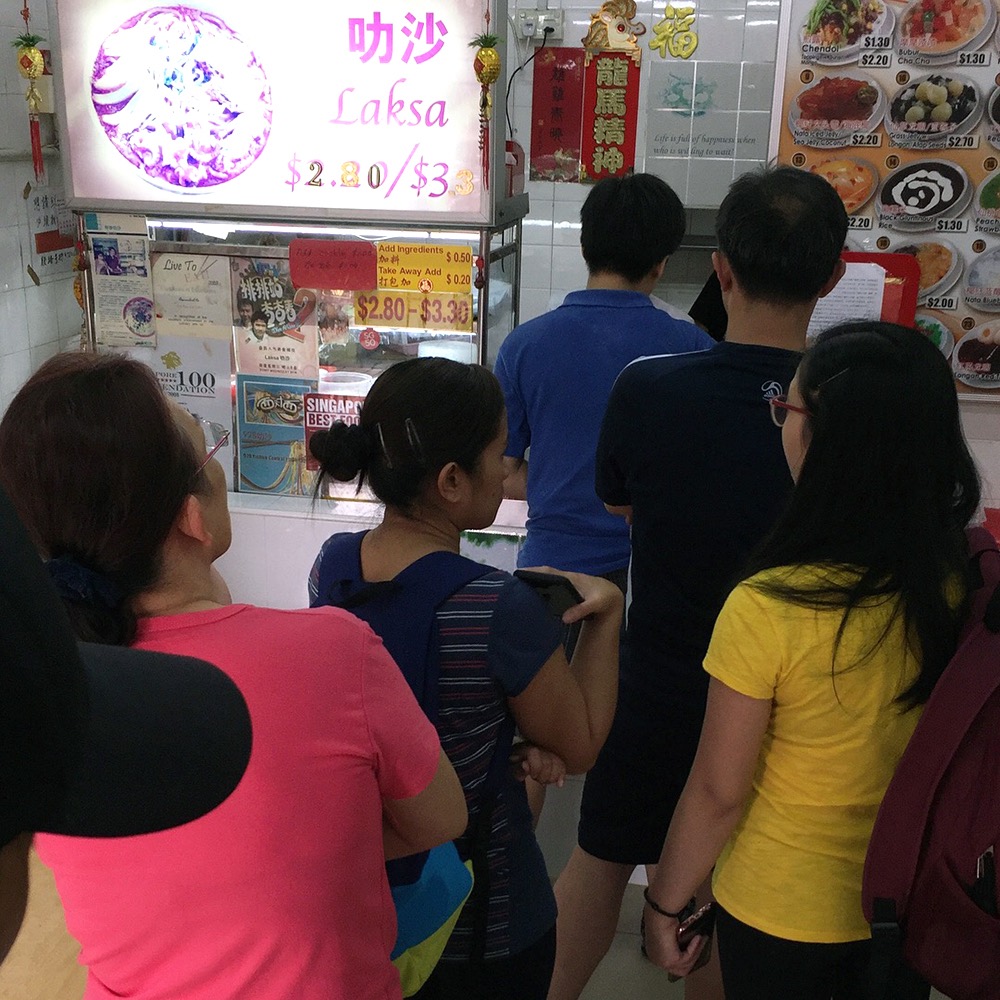
The blockbuster Laksa name that you will usually encounter is ‘Katong Laksa’. Katong is a district in the East, and what’s special about the ‘Katong-style Laksa’ that originated there, is the more soupy broth and cut up noodles that you eat with a spoon.
Many stalls have claimed to be the original Laksa, with the most famous being 328 Katong Laksa of Michelin fame, but I found that to be the worst of the lot with their thin flimsy broth. Instead, the other commercialised juggernaught known as Janggut Laksa was much better and apparently hailed as the true originator of Katong Laksa, having been established since 1940!
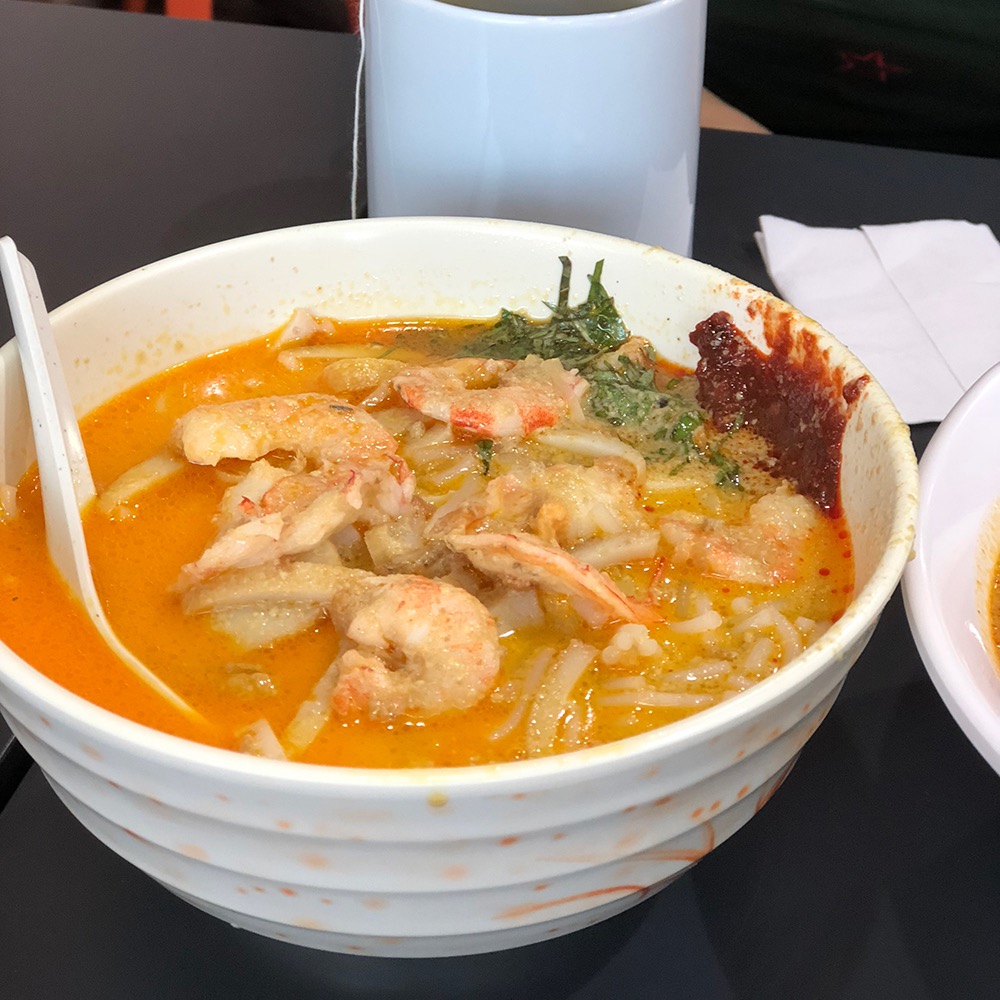
Find my favourite Laksa stalls in Singapore here:
Yishun 928 That Very Nice Laksa Place
Corner of Block 928 Yishun. You will spot a queue snaking around a dessert stall, that is it.
Janggut Laksa (3 outlets)
- 331 Upper Paya Lebar Rd
- 1 Queensway, #1-59, Queensway Shopping Centre
- 50 East Coast Road, Roxy Square
2. Chicken Rice
Chicken rice is said to be the official national dish of Singapore, even though it was conceived by the Hainanese immigrants from China and became famous only in it’s localised version.

Hainanese chicken rice can now be found virtually in most China towns of the western world.
With such critical acclaim, you can be sure to find hundreds of stalls selling Hainanese chicken rice. The typical factors to judge a good chicken rice are:
The fragrance of the rice; The rice should be fragrant with a hint of ginger, scallions, pandan and savoury enough to eat on it’s own. Rice grains should not be mushy but remain separated with a wee bit of bite.

The tenderness of the chicken; Sadly the chicken quality in Singapore is not as good as ones I’ve eaten abroad. In terms of flavour, the chickens sourced here are quite bland.
When it comes to tenderness, practically everyone does it right. The chicken flesh, be it breast or thigh meat should come apart easily with a fork and spoon.
Do not, however mistake tender with mushy. The meat should retain a bit of bounce to it and not be crumbly which is when some hawkers flatten the breast meat with the backs of the cleaver to make a smaller piece look larger and softer.

The chilli sauce; Singapore style chilli sauce has a strong flavours of garlic and calamansi lime. The typical recipe also involves finishing the chilli sauce with a hit of chicken stock, which adds that secret ingredient umami finish to it. A good chilli sauce should neither be too spicy nor sour, and instead, a fine balance that simply ‘tastes good’.
Now there are tons of good chicken rice stalls, famous and nondescript ones alike, here are two that I frequent the most but they are by no means the best in the city.

Yishun 925 Chicken Rice (this is only a block away from the famous laksa place!)
Yishun Block 925 Coffee Shop. The Chicken Rice stall is at the corner and practically every other table here will be ordering from them. You can also go for Laksa at the 928 Laksa place after this (which I always do) which is just a block away.

Wee Nam Kee Chicken Rice
Original shop at 101 Thomson Road, #01-08 United Square, though they have now expanded as a franchise and can be found at some shopping malls including North Point City, a stones throw away from the above Yishun 925 Chicken Rice.

That said, I’ve found the quality of their branches to be lower than that of their original store.
3. Char Kuay Teow
Char (Fried) Kuay Teow might be tricky to pronounce, but trust me, it is worth learning the name.

Fried flat rice noodles essentially, with cockles, fish cakes and often, Chinese sausages, doused with a sweet soy sauce. The noodles are fried with pork lard and infused with the smokey aroma of a seasoned wok that had been frying the same thing for tens of years.
This is a high calorie count dish, but the same can be said for most Singaporean dishes (and for most tasty dishes for that matter).
The absolute best one in my books is a ways away in a heartland estate to the East, at Bedok South Market.

Hill Street Fried Kuay Teow
The original owner and chef had been frying the same dish for over 40 years, and the char kway teow lineage nearly ended before one of his sons finally agreed to take over the reigns and continue the legacy.
Hill Street Char Kuay Teow is simply, perfect. It is the place where I bring my visiting friends to, for a genuine and spectacular local experience.
The texture of the flat rice noodles are soft yet supple, contrasted with the crunchy mung bean sprouts.
The flavours, an explosion of sweet, salty, smokey, savoury and spicy.
Seriously, just look up the directions, take a bus or even a taxi for that matter and try it. Expect to stand in line for at least 30mins.
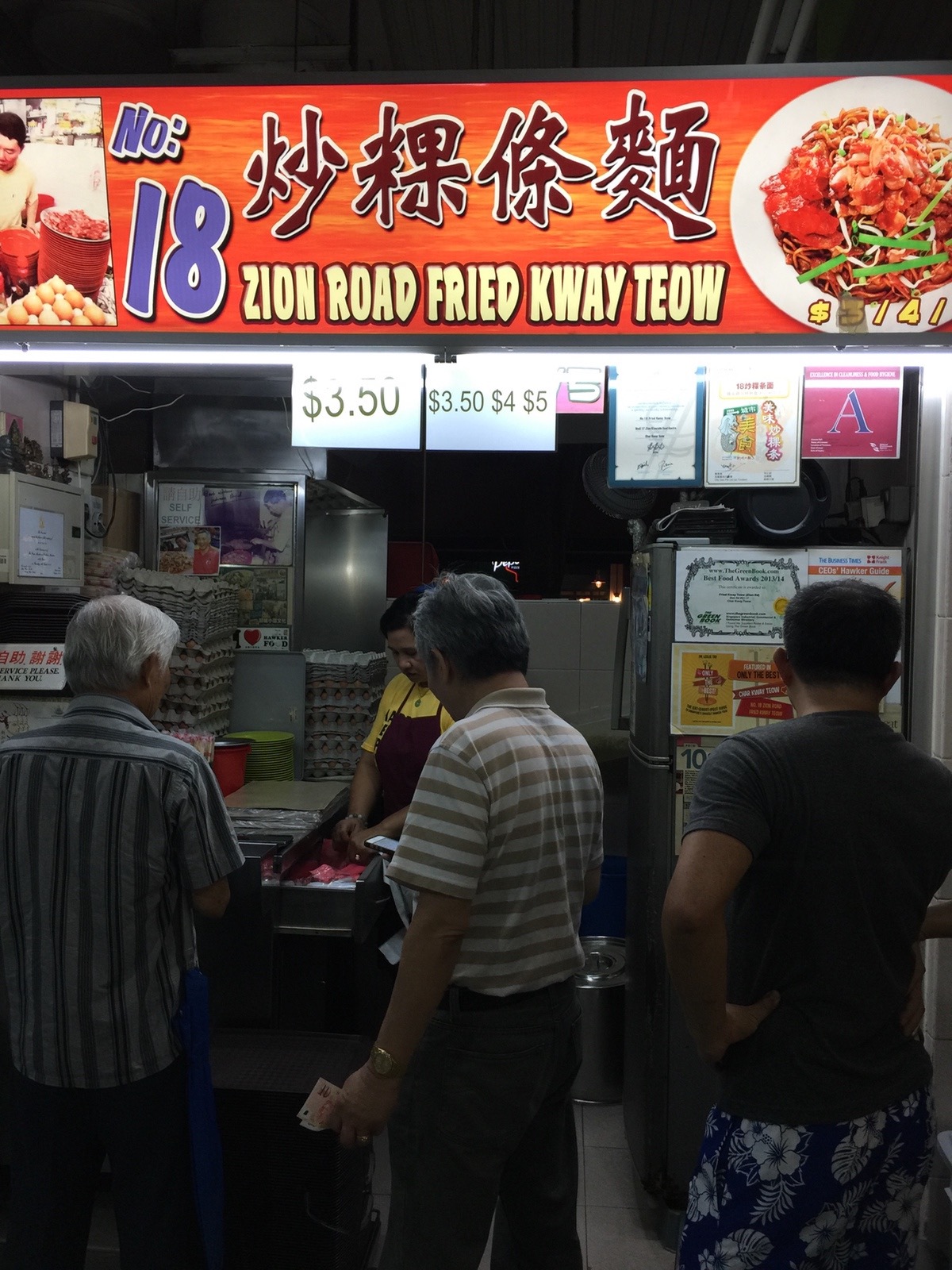
Zion Rd Fried Kuay Teow
Zion Rd was also highly recommended when I first came back to Singapore, and I’ve tried them a number of times. The style here is also great, with stronger in your face flavours, more charring and dark sauce.

Find my best char kuay teow stalls here:
Hill Street Fried Kuay Teow
16 Bedok South Rd, #01-41
Zion Rd Fried Kuay Teow
70 Zion Rd
4. Chai Tow Kuay / Char Kuay (Fried Carrot Cake)
Singapore style fried carrot cake is a bit of a misnomer, because no carrots are actually used. Instead, the carrot actually refers to radish or daikon. No idea when the actual English name was coined, but it was likely because the Chinese word for ‘carrot’ can refer to both carrots and radishes.

Singapore style fried carrot cake originates from the Teochew area of China.
The main component is a soft pliable cake made from rice flour and fried with lard, garlic and beaten eggs to form a crisp and slightly charred cakes.
Dried radish are added during the frying process for added hits of umami-ness. This is also where the white and black versions come in. If you ordered the black version, sweet dark soy sauce would be added to the frying process here.
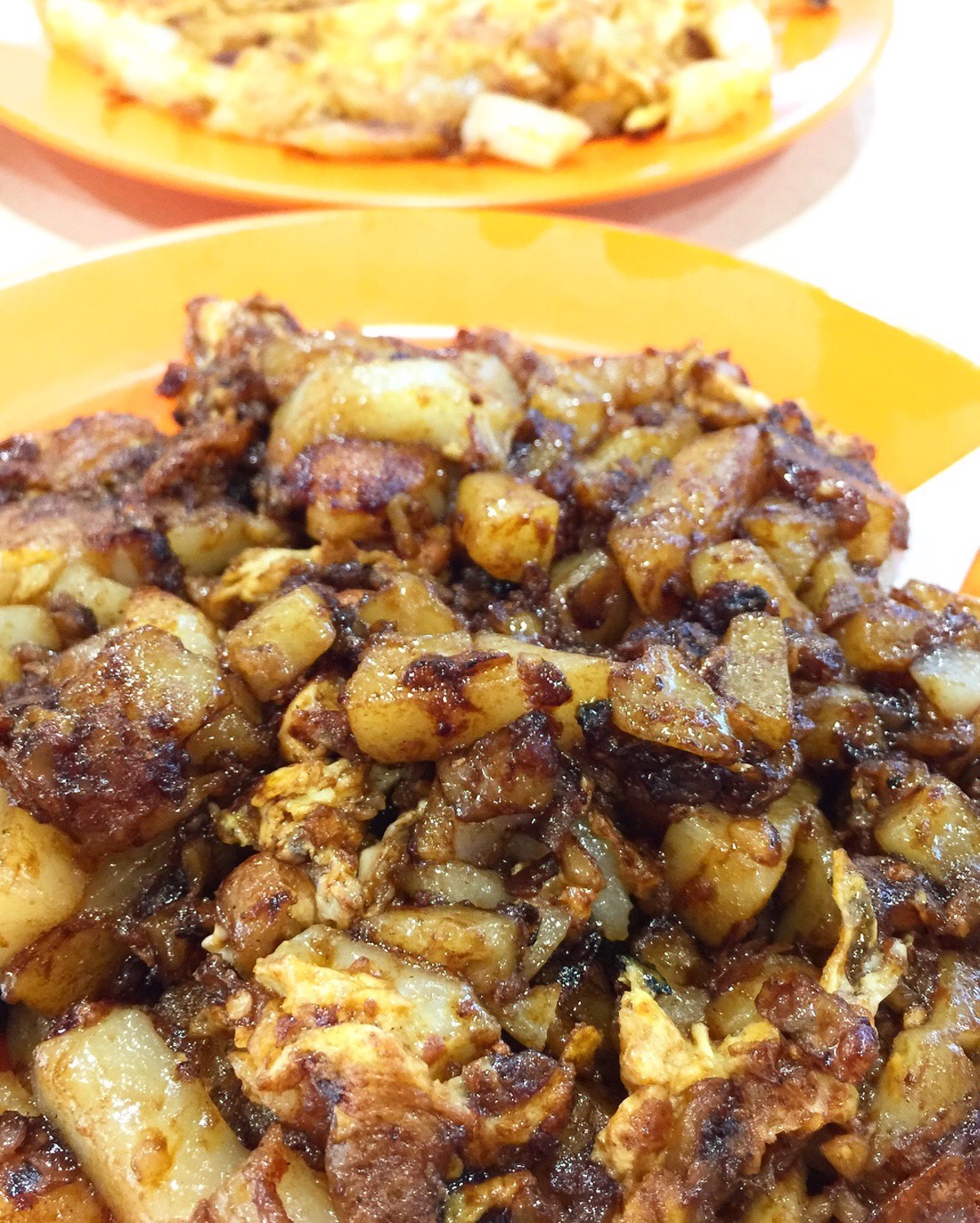
This dish is not to be confused with the cantonese variant of radish cake, in which the cakes consist primarily of radish and fortified with rice flour.
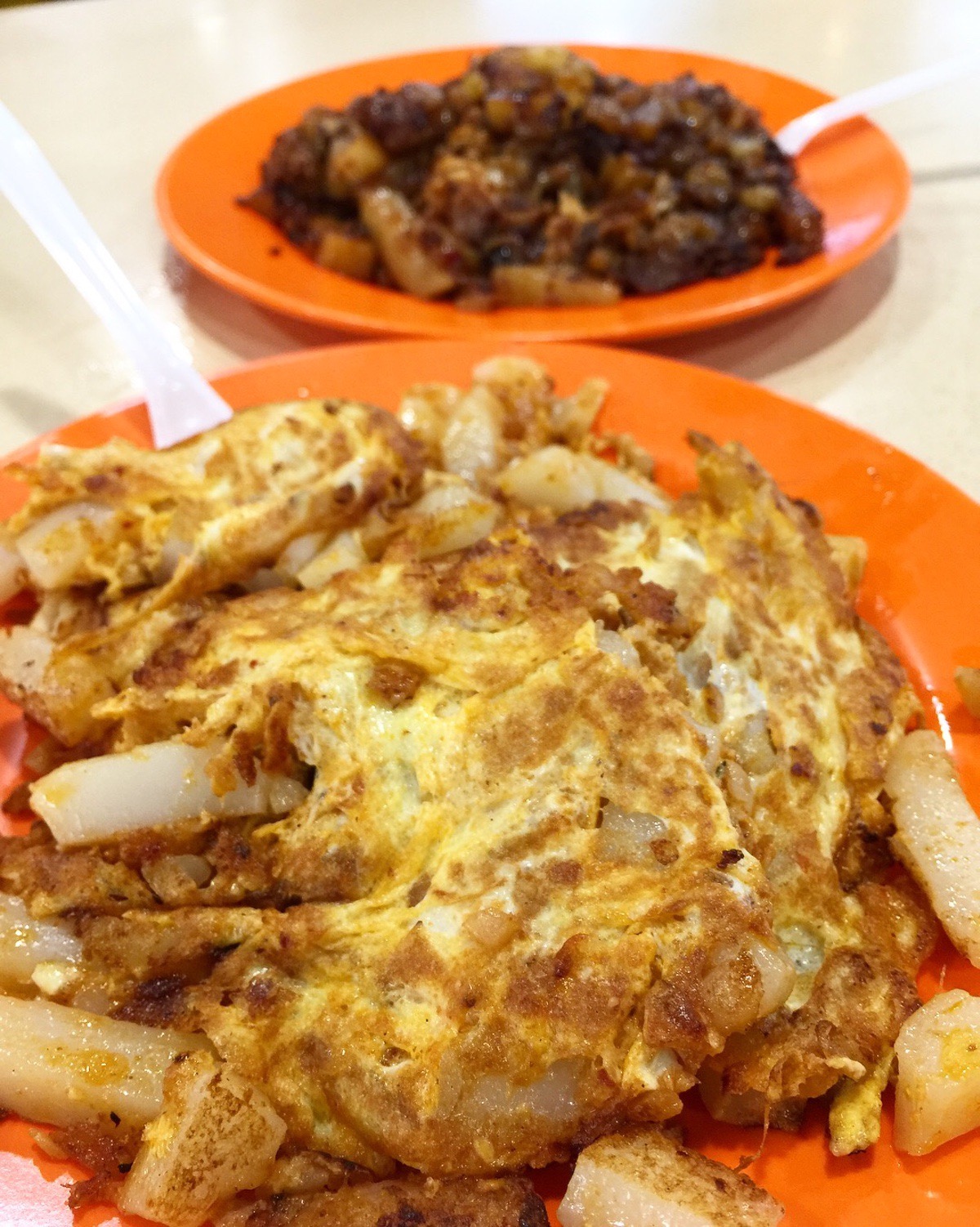
A good fried carrot cake should have an initial dry, crispy crunch, followed by a soft and hot interior within each piece. It should taste very savoury with a bit of garlicky flavours and that something you cannot put your finger on taste (which most of the time is pork lard).
Fried carrot cake can be found literally at any food court, but one nostalgic one that I visit often is right by my home, at Block 233 Yishun. At only $2.50, each plate looks simple, but tastes complex and more importantly, has that nostalgic childhood taste.
If you are at Chomp chomp, you might also want to order from the Fried Carrot Cake corner stall. I’ve tried it before and it’s pretty decent. Chomp Chomp Food Center is located at 20 Kensington Park Rd, and you will see me repeating this name very soon. Take note that Chomp Chomp only opens in the evenings (after 5pm)

5. Hokkien Mee
The name Hokkien refers to the Fujian province of China. A large majority of the Chinese in Singapore immigrated from Fujian and placed a big influence on the Chinese food in Singapore.

While Hokkien Mee (Hokkien noodles) can refer to a number of noodle dishes, the default understanding usually points to a noodle dish wok-fried with lard, infused with a pork and prawn stock and topped with fresh prawns, pork belly and squid.

My favourite one is at Chomp Chomp Food Center which only opens in the evenings. Another good one is at Circuit road food centre as I had previously written about, but unfortunately, the entire food center is currently closed for renovations.
Another popular Hokkien Mee I used to patronise was at Lor 29 Geylang, however in recent times, I’ve found theirs to be a little pricey for what you can get at other places.
Here’s the photo and address of the best Hokkien mee stalls:

Chia Keng Hokkien Mee
Chomp Chomp Food Center, 20 Kensington Park Rd. This food center only opens in the evening.
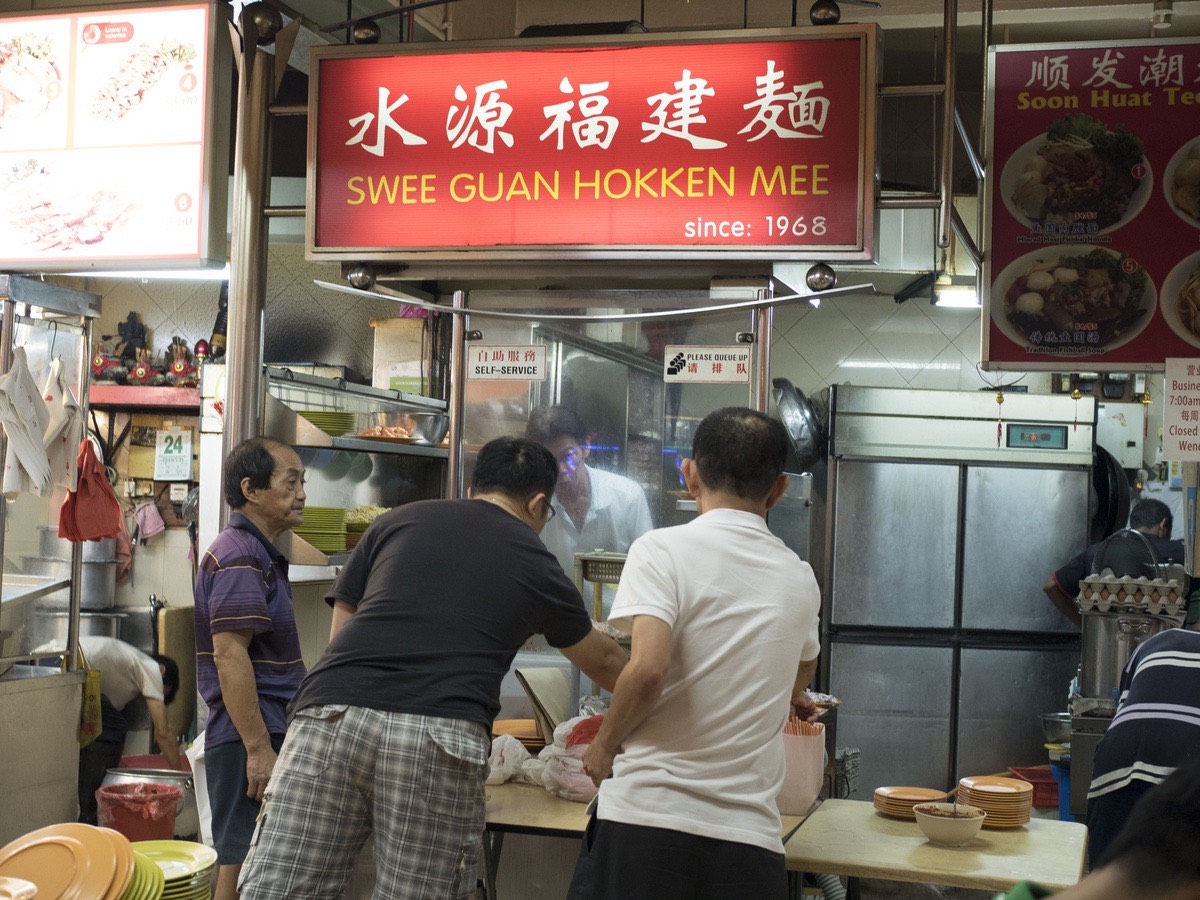
Swee Guan Hokkien Mee
Geylang Lorong 29 Coffeshop, right by the road.
6. Satay
Satay are the quintessential Southeast Asian meat skewers. There are so many variations of it in nearly every country, from Thailand to Malaysia to Indonesia, and they all taste slightly different in every city. However my favourite version still has to be the Hainanese adaptation in Singapore.

The key difference in the Hainanese version is that there are pork skewers, which is unavailable in most muslim cities. I always go for Pork Satay because there is always this piece of caramelised fatty piece in the center that is bursting with flavour.

Traditional Singapore Hainanese style satay also feature a pineapple puree to go with the rich and spicy peanut dipping sauce. The sweet and slightly tart taste of the fresh pineapple puree balances out the rich and savoury peanut sauce remarkably well.
One interesting pattern to note is that often at places that sell Satay, you will find the above Hokkien Mee being sold nearby if not side by side.

My favourite places to enjoy Satay is at Chomp Chomp Food Centre, Kwong Satay at Geylang Lor 29 and at Circuit Road Food Center before they closed for renovation. Yes, all these 3 places were also featured in my recommendations for Hokkien Mee! What are the odds?!
7. Sambal Stingray
Most people I’ve known outside of Singapore have neither known nor tasted Stingray before, except for my French buddy from Shanghai (He claims to have eaten it growing up in France). Therefore I always bring my visiting guests to sample one of my favourite Singaporean delicacies — Sambal grilled Stingray.

Stingray fillets have stringy flesh almost like chicken but more flavourful and tender. The fillets are grilled or sometimes pan-fried over a banana leaf before being slathered with the stall’s signature sambal chilli sauce. The result is a smokey grilled fish with a hint of charred banana leaves and sambal flavours.

My two favourite places to eat this is at Chomp Chomp Food Center, where there are no less than 5 stalls selling grilled seafood, along with many other goodies featured elsewhere in this list. Contrary to popular belief that the front facing stalls serve the weakest food, I’ve found the first two stalls facing the entrance actually served a pretty good Stingray.
I have a secret recommendation for Sambal Stingray! Find out how to discover my secret recommendations soon.
8. Chendol
Taking a break from the heavy hitting savoury dishes, I bring to your attention one of the best loved desserts in the Malaya region — Chendol.

I believe this dessert originated in Malaysia, and from my experience, they do not differ much with the Singapore version.
Essentially, shaved ice with coconut milk, palm coconut syrup with a green noodle and sometimes red beans.
Find this at all local dessert stalls, and they are usually quite decent, but for the ultimate chendol in a hipster setting, go to The Coconut Club at Ann Siang Hill, just a stones throw away from China town. Read about my full review of the coconut cub here.
If you’re feeling adventurous, you can visit a food center in a local residential estate at 210 Toa Payoh Lor 8. Four Seasons Chendol stall sells only one thing, Chendol at $2. When a stall in a bustling food center remains popular by selling only one item, you can be certain that it is good. Even a past prime minister had visited this stall!
9. Roti Prata
Diversifying a little bit, roti prata is a dish of south Indian origin, spelled paratha in India, but simplified to prata in Singapore. They are wheat flour pan cakes tossed, slapped and folded several times before being fried with ghee.

Traditionally, roti pratas are eaten with a side of mutton or fish curry.
The two most common ways of ordering them are ‘kosong’ which is ‘empty’ or rather plain, without any fillings, or with egg, whereby an egg is cracked into the prata during the frying process.
In recent years, more creative fillings have been introduced like cheese, mushrooms, onions and more.
A great prata should be thoroughly crispy on the outside, super flaky with many layers and slightly chewy within.
One of the most popular and famous prata vendor is Mr and Mrs Moghan’s Super Crispy Prata, located at a tiny coffee shop smack in the middle of a bungalow estate.
Mr and Mrs Mohgan’s Super Crispy Roti Prata
7 Crane Road
10. Bak Chor Mee
Saving the best for the last, we have Bak Chor Mee, which means minced meat noodles in the Hokkien dialect.

The dish is a popular noodle tossed in pork lard, vinegar and house-made chilli sauce.
Common toppings include minced pork, fish cakes, sometimes fish balls, and often braised mushrooms.
People eat this from any and all times of the day, and one of the Michelin one star hawkers in Singapore sells just this — Hill Street Tai Hwa Pork Noodle.

There are many, many great bak chor mee stalls selling bak chor mee all over the island, with at least a good half that I have not eaten yet. Here are some of my favourites.
- Hlil Street Tai Hwa Pork Noodle
466 Crawford Ln, #01-12 (Expect to queue an hour)
- Soon Heng Fishball Minced Meat Noodle
628 Ang Mo Kio Ave 4 (Under renovations until June 2018) - Lam’s Noodles (various outlets)
Original shop, Lam’s @ 460 Race Course Rd,
Lam’s @ Ion, 2 Orchard Turn ION Orchard #B4-03/04
Their salt baked chicken thigh is also very good.
I have an ultimate secret hidden gem that I will recommend in the near future to exclusive readers.
And that’s it, my top 10 must eats in Singapore for the first time visitor. This is only the first of a series of articles, because there are simply too many varieties of great tasting food in Singapore to choose from.
Also, these are not meant to be extremely comprehensive guides, but rather a guideline to the types of food you can choose from, rather than specific recommendations.
Let me know in the comments what you think especially after you had followed the guide!
